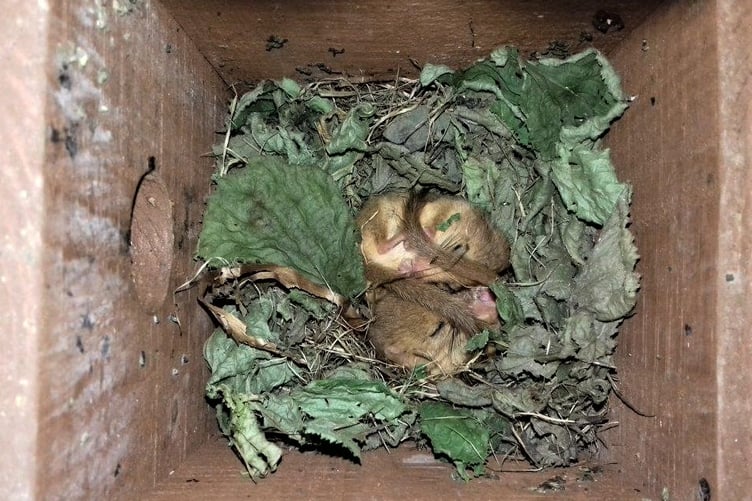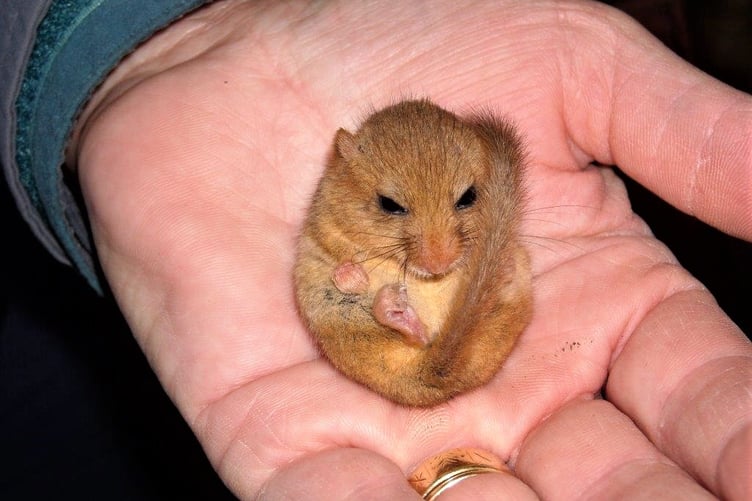There are two species of dormouse in Britain, the common or hazel dormouse (Muscadinus avellanarius) and the edible dormouse (Glis glis), which are still eaten in some eastern European countries, and were introduced into the UK in 1902.
Edible dormice are grey and much larger than common dormice, whose bodies measure about two and a half inches plus a long furry tail. The edible dormouse is grey, whereas the common dormouse is a golden colour, greying slightly on the back.
The common dormouse is native to Britain and has been here since the Ice Age. It is not, as its name might suggest, common but its decline went unnoticed for some time.
Some 200 years ago, dormice inhabited every county in England and Wales except Norfolk and Northumberland. But a survey carried out in the late 1970s, after naturalist and author Elaine Hurrell and her father discovered the unique way that dormice open hazelnuts, revealed that they had disappeared from almost half of their previous habitats
This decline in numbers was due to changes in woodland and hedgerow management. Dormice like to live in ancient woodland where a mixture of trees and shrubs provide food throughout the year.
Their remaining strongholds are in the southern counties of England and Wales, where there have been successful re-introductions recently.
In 1993, thousands of volunteers crawled about in woodlands looking for the distinctively-opened nutshells. These have toothmarks round the outer edge of the round hole, but the inner edge is smooth.
Another nut hunt, organised in 2001, led to a national dormouse monitoring programme being introduced and my wife Sheila and I became involved. We gained our handling licence in 2002 and have been monitoring a site near Wootton Courtenay ever since. We also check out other sites on Exmoor.
Dormice are nocturnal and spend almost their entire lives up in the tree canopy foraging for food. They eat nectar and flowers in spring and insects in summer.
In autumn they fatten themselves up with fruit such as blackberries and nuts, ready for hibernation. They need to gain enough weight to survive hibernation: at least 12 to 15 grams of food per dormouse.

In November, dormice look for places to hibernate, such as holes under tree roots or in log piles. This may be the only time they descend to ground level. Some are eaten by badgers, foxes, stoats or weasels. Those who survive usually wake up in April. If it is too cold or wet to feed they can go into torpor - a kind of deep daytime sleep.
Breeding dormice pair up in late June or July. They choose a suitable nest site such as a prickly bramble bush or a natural hole in a tree. They also use nest boxes which is handy for us monitors.
These have an entrance hole at the back to allow access from the tree canopy. A word of warning: dormice and their nest sites are protected by law - it is an offence to disturb them without a licence and the punishment is quite severe - a £1000 fine or worse.
The nests are usually made of strips of honeysuckle bark, plus grass or bracken woven into a ball. The hole at the back leads to a cavity inside.
In a natural nest they use fresh leaves for waterproofing and they do this, perhaps instinctively, in nest boxes even though the nest box has a lid. Breeding nests are about the size of a grapefruit, but nests for roosting or hibernating are smaller.

The main breeding season is July and August and it is rare to find babies in June. We do find babies in September and, rarely, October although these will struggle to survive hibernation, unless we have an unusually mild and dry autumn with enough food available.
The gestation period is about 25 days and the average litter size is four. Youngsters stay with their mother for six to eight weeks before they are able to be independent but will often stay for longer, learning how to forage.
This is why dormice usually have only one litter per year, in contrast to mice with their six litters, but the lifespan of a dormouse is much shorter. However, mice and voles on the forest floor are in more danger from predators.
So they are unlikely to survive more than six months whereas dormice in the wild can live on average four or five years and up to seven in captivity. Tina Donnelly, who trained us, cared for a male which lived for nine years in her captive breeding unit in Dulverton.
The main danger to dormice is the damage we humans are doing by destroying their habitat and global warming which is changing our weather patterns.
This affects the survival of many creatures, including dormice, which need cold winters to remain in hibernation. Warm spells in January and February wake them up and they then waste energy looking for non-existent food.
They go back to sleep but may never wake up again. So the future for dormice in Britain is uncertain. But let us hope that they will be able to adapt quickly to deal with these new threats.
For more information about the work of the Exmoor Natural History Society visit www.enhs.org.uk

-coastal-defence-at-Bossington-Som.jpeg?width=209&height=140&crop=209:145,smart&quality=75)



Comments
This article has no comments yet. Be the first to leave a comment.